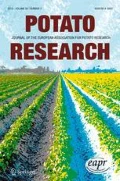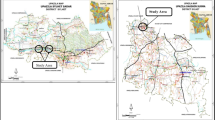Abstract
The nitrite and nitrate in foodstuff and their associated harmful effects are of great concern for human health. More than 80% of human nitrate intake is attributed to the consumption of vegetables and fruits, and for this reason, more attention should be paid to the consumption of such foodstuffs and reduction of nitrate intake. Therefore, this study aimed to determine the variation of nitrate and nitrite content in potato during home preparation, process, and cooking methods, and assessed their health risk in different age groups for the first time in Iran. The nitrite content in all of the samples was lower than the apparatus detection limit so results are reported for nitrate. A total of 471 tubers of potato cultivar Diamant were assessed. The nitrate content was measured based on the tuber weight and also in different parts of potato. The impact of different washing and baking methods on nitrate contents were also assessed. Ion chromatography was employed to determine the nitrate content. The US Environmental Protection Agency (EPA) method covering the determination of nitrate in food was used to assess the health risk associated with potato consumption. The results showed that the average nitrate content was 123.26 mg/kg which was lower than the safe limit of nitrate. The results also showed that the total amount of nitrate in potato peel was 35% higher than in its central parts. Different washing methods could reduce the nitrate amount by 7.79 to 14.73%. Boiling potato could significantly reduce the amount of nitrate by 59.7%, while frying increased it by 52%. There were significant differences among different potato cooking methods in terms of changes in the nitrate content (P ˂ 0.001). This means that exposure in all age groups was less than the standard limits and potato intake was considered safe to all age groups. As there were significant changes in the nitrate content, it was concluded that washing and cooking methods, except frying, were suitable methods to reduce nitrate intake.


Similar content being viewed by others
References
Ardakani S, Shayesteh K, Afiooni M, Mahboobi N (2005) Nitrate concentration in some of vegetable products Esfahan. Environ Sci 37:69–76
Boroujerdnia M, Ansari NA, Dehcordie FS (2007) Effect of cultivars, harvesting time and level of nitrogen fertilizer on nitrate and nitrite content, yield in Romaine lettuce. Asian J Plant Sci 6:550–553
Brkić D, Bošnir J, Bevardi M, Bošković AG, Miloš S, Lasić D, Krivohlavek A, Racz A, Mojsović-Ćuić A, Trstenjak NU (2017) Nitrate in leafy green vegetables and estimated intake. Afr J Tradit Complement Altern Med 14:31–41
Carter J, Bosma S (1974) Effect of fertilizer and irrigation on nitrate-nitrogen and total nitrogen in potato tubers 1. Agron J 66:263–266
Chetty AA, Prasad S (2009) Flow injection analysis of nitrate-N determination in root vegetables: study of the effects of cooking. Food Chem 116:561–566
Ekart K, Hmelak Gorenjal A, Madorran E, Lapajne S, Langerholc T (2013) Study on the influence of food processing on nitrate levels in vegetables. EFSA Support Publ 10:514E
Hamedani MY (2003) A study of the effect of nitrogen rates on yield, yield components and nitrate accumulation in potato varieties. Iran J Agric Sci 34:977–985
Hsu J, Arcot J, Lee NA (2009) Nitrate and nitrite quantification from cured meat and vegetables and their estimated dietary intake in Australians. Food Chem 115:334–339
ISIRI (2015) Vegetables and vegetable products - determination of nitrate and/or nitrite content - part 2: HPLC/IC method for the determination of nitrate content. Institute of Standards & Industrial Research of Iran, Amendment No. 1 (Standard No. 2-16721)
Javed M, Usmani N (2016) Accumulation of heavy metals and human health risk assessment via the consumption of freshwater fish Mastacembelus armatus inhabiting, thermal power plant effluent loaded canal. SpringerPlus 5(1):776
Joossens JV, Hill M, Elliott P, Stamler R, Stamler J, Lesaffre E, Dyer A, Nichols R, Kesteloot H (1996) Dietary salt, nitrate and stomach cancer mortality in 24 countries. Int J Epidemiol 25:494–504
Leszczyńska T, Filipiak-Florkiewicz A, Cieślik E, Sikora E, Pisulewski PM (2009) Effects of some processing methods on nitrate and nitrite changes in cruciferous vegetables. J Food Compos Anal 22:315–321
Malekouti MJ, Tabatabai SJ (2006) Chemical and organic fertilization for yield increasing and controlling the nitrate concentration in potato tubers of Iran. Technical Report No 15, Agricultural Education Publication, Ministry of Agriculture, Karaj
Metrohm (2016) Application. Determination of chloride, nitrate, phosphate, sulfate, and oxalate in dried potatoes using anion chromatography with direct conductometric detection, AN-N-006
MHME (2013) Suitable food basket for Iranian society. Ministry of Health and Medical Education, National Number: 3293288, Tehran, Iran
Mozolewski W, Smoczyñski S (2004) Effect of culinary processes on the content of nitrates and nitrites in potato. Pak J Nutr 3:357–361
Pirsaheb M, Sharafi K, Morad M (2013) A survey on nitrite and nitrate levels in vegetables and cucurbits cultivated in northern and western plains of Kermanshah city in 2012. J Food Hyg 3:77–87
Prasad S, Chetty AA (2008) Nitrate-N determination in leafy vegetables: study of the effects of cooking and freezing. Food Chem 106:772–780
Quijano L, Yusà V, Font G, McAllister C, Torres C, Pardo O (2017) Risk assessment and monitoring programme of nitrates through vegetables in the region of Valencia (Spain). Food Chem Toxicol 100:42–49
Rytel E, Pęksa A, Tajner-Czopek A, Kita A, Lisińska G (2011) Anti-nutritional compounds in potatoes, depending on the type of raw material and conditions of processing potatoes into food products. Food (Special Issue 1):15–22
Sadeghi E, Hashemian A, Mohammadi M, Bohlouli Oskoii S, Meskini H, Mohammadi R, Almasi A (2013) Study on the effect of boiling and freezing process on nitrate and nitrite levels in abundant consumed vegetables. Iran J Nutr Sci Food Technol 8:201–208
Sadeghi E, Sharafi K, Almasi A, Dayhim M, Azizi E, Ghayebzadeh M (2015) Study on the nitrite and nitrate levels changes by drying and frying processing in vegetables. Iran J Health Environ 7:491–498
Saeidi M, Tobeh A, Raei Y, Roohi A, Jamaati-e-Somarin S, Hassanzadeh M (2009) Evaluation of tuber size and nitrogen fertilizer on nitrogen uptake and nitrate accumulation in potato tuber. Res J Environ Sci 3:278–284
Santamaria P (2006) Nitrate in vegetables: toxicity, content, intake and EC regulation. J Sci Food Agric 86:10–17
Shahbazzadegan S, Hashemimajd K, Shahbazi B (2010) Determination of nitrate concentration of consumed vegetables and fruits in Ardabil. J Ardabil Univ Med Sci 10:38–47
Tamme T, Reinik M, Roasto M, Juhkam K, Tenno T, Kiis A (2006) Nitrates and nitrites in vegetables and vegetable-based products and their intakes by the Estonian population. Food Addit Contam 23:355–361
Thorup-Kristensen K (2006) Root growth and nitrogen uptake of carrot, early cabbage, onion and lettuce following a range of green manures. Soil Use Manag 22:29–38
Yeganeh M, Bazargan K (2016) Human health risks arising from nitrate in potatoes consumed in Iran and calculation nitrate critical value using risk assessment study. Hum Ecol Risk Assess 22:817–824
Ziarati P, Arbabi-Bidgoli S (2014) Investigation of cooking method on nitrate and nitrite contents in crops and vegetables and assess the associated health risk. Int J Plant Anim Envir Sci 4:46–52
Acknowledgements
This manuscript is extracted from the project approved by the Environmental Health Research Center, Kurdistan University of Medical Sciences, with the file number IR.MUK.REC.1395/179.
Author information
Authors and Affiliations
Corresponding authors
Ethics declarations
Conflict of Interest
The authors declare that they have no conflicts of interest.
Additional information
Publisher’s Note
Springer Nature remains neutral with regard to jurisdictional claims in published maps and institutional affiliations.
Rights and permissions
About this article
Cite this article
Ebrahimi, R., Ahmadian, A., Ferdousi, A. et al. Effect of Washing and Cooking on Nitrate Content of Potatoes (cv. Diamant) and Implications for Mitigating Human Health Risk in Iran. Potato Res. 63, 449–462 (2020). https://doi.org/10.1007/s11540-020-09450-4
Received:
Accepted:
Published:
Issue Date:
DOI: https://doi.org/10.1007/s11540-020-09450-4




